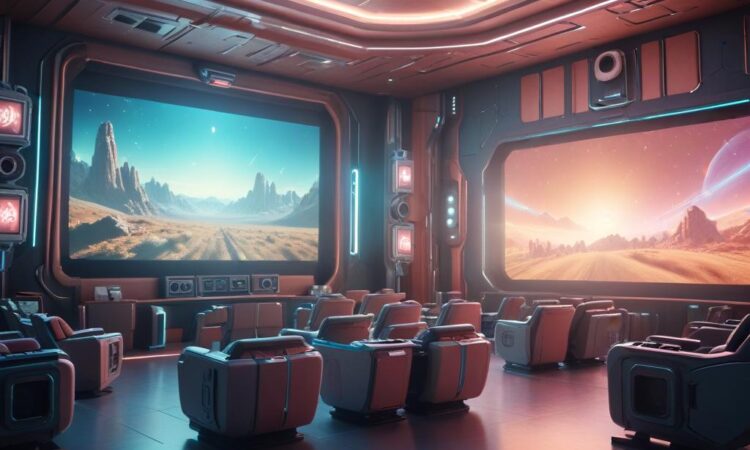The Future of Cinema Technology
This theme delves into the exciting realm of cutting-edge advancements in cinema technology, exploring emerging trends that are revolutionizing filmmaking equipment, visual effects, and immersive viewing experiences. We’ll analyze the potential impact of these technologies on the future of storytelling and the cinematic experience, uncovering how they are shaping the way we create and consume movies.
Emerging Trends in Filmmaking Equipment
The world of filmmaking equipment is constantly evolving, with new technologies emerging at an impressive pace. Here are some key trends:
1. High-Dynamic Range (HDR) Cameras
HDR cameras capture a wider range of light and shadow detail, resulting in stunningly realistic and visually immersive images. This technology allows filmmakers to create more lifelike visuals, with greater depth and clarity, enhancing the overall cinematic experience.
2. Artificial Intelligence (AI) in Filmmaking
AI is rapidly making its mark on the filmmaking process, from scriptwriting and storyboarding to editing and visual effects. AI algorithms can analyze vast amounts of data to generate creative ideas, optimize workflows, and automate repetitive tasks, freeing up filmmakers to focus on the artistic aspects of their craft.
3. Virtual Reality (VR) and Augmented Reality (AR) Cameras
VR and AR cameras are blurring the lines between reality and the digital world, allowing filmmakers to create immersive and interactive experiences. These technologies offer new ways to tell stories, engage audiences, and transport viewers into virtual worlds.
Visual Effects: Pushing the Boundaries of Reality
Visual effects (VFX) have come a long way, and the advancements in this field are nothing short of astounding. Here are some notable trends:
1. Real-Time Rendering
Real-time rendering allows VFX artists to see their work come to life instantly, eliminating the need for lengthy rendering processes. This technology enables more dynamic and interactive visual effects, making the filmmaking process more efficient and collaborative.
2. Motion Capture (MoCap) Technology
MoCap technology captures human movement and translates it into digital animation, creating lifelike and expressive characters. Advancements in MoCap have led to increasingly realistic and detailed character animations, blurring the lines between reality and CGI.
3. Procedural Generation
Procedural generation algorithms allow artists to create complex and intricate visuals with minimal manual intervention. This technology is revolutionizing the creation of environments, textures, and other visual elements, freeing up artists to focus on artistic direction.
Immersive Viewing Experiences
The way we watch movies is evolving, with new technologies offering increasingly immersive viewing experiences. Here are some key trends:
1. High-Definition (HD) and 4K Resolution
Higher resolution displays provide sharper and more detailed images, enhancing the overall visual experience. 4K and even 8K resolution displays are becoming increasingly common, offering a level of detail and clarity that was previously unimaginable.
2. Dolby Atmos and Immersive Sound
Dolby Atmos and other immersive sound technologies create a more realistic and enveloping audio experience. These systems use multiple speakers and advanced sound processing techniques to create a three-dimensional soundscape that surrounds the viewer.
3. Virtual Reality (VR) and Augmented Reality (AR) Cinema
VR and AR are transforming the cinema experience, allowing viewers to immerse themselves in virtual worlds and interact with digital content. These technologies offer new ways to tell stories, engage audiences, and transport viewers into different worlds.
The Impact of Cinema Technology on Storytelling
Advancements in cinema technology are not only impacting the technical aspects of filmmaking but also influencing the very nature of storytelling. Here are some key impacts:
1. Expanded Narrative Possibilities
New technologies are enabling filmmakers to tell stories in ways that were previously impossible. VR and AR offer interactive narratives that allow viewers to shape the story, while real-time rendering allows for more dynamic and unpredictable sequences.
2. More Realistic and Engaging Visuals
Advances in VFX and HDR create more realistic and immersive visuals, enhancing the emotional impact of storytelling. These technologies allow filmmakers to transport viewers into different worlds and evoke a deeper connection with the characters and events on screen.
3. Increased Audience Engagement
Immersive viewing experiences, such as Dolby Atmos and VR, create a more intimate and engaging connection between the audience and the story. These technologies allow viewers to fully immerse themselves in the world of the film and experience the emotions of the characters more intensely.
The Future of Cinema
The future of cinema is bright, with emerging technologies promising to revolutionize the way we create and consume movies. As technology continues to advance, we can expect even more immersive and engaging cinematic experiences, pushing the boundaries of storytelling and entertainment.
The future of cinema is a journey of discovery, where technology and creativity intertwine to create breathtaking experiences that transport audiences to new worlds and inspire them with stories that stay with them long after the credits roll.

